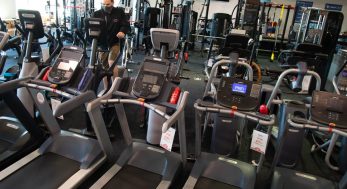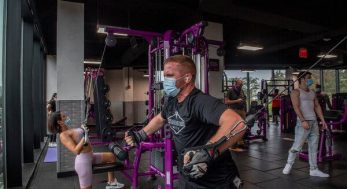
Young woman using phone in gym.
Despite the fact that many people don’t trust social media as a source for news, according to a recent survey from the Cleveland Clinic and Parade magazine 44% of Americans turn to Facebook, Twitter, Instagram and YouTube for health, fitness and diet advice. The survey also found that 18% of respondents even changed their fitness regimen based on advice from social media, while another 18% changed their diet!
Perhaps this isn’t surprising as a Broadband Search report found that the average American spends nearly two and a half hours each day on social media, an increase of an hour a day – or a 62.5% – increase from time spent in 2012.
The Cleveland Clinic and Parade magazine study also found that 55% of women respondents, aged 25-49, had taken personal health or fitness actions based on info/advice from social media.
Dr. Mark Hyman, M.D., director of the Cleveland Clinic Center for Functional Medicine, said that while some experimentation does have “fantastic outcomes,” other trending health habits could be potentially dangerous. Hyman warned that there a lot of false health claims and it is important for users to ask where the information or advice is coming from.
A 2018 George Washington University-led study found that many anti-vaccination tweets were coming from Russia. The research, “Weaponized Health Communication: Twitter Bots and Russian Trolls Amplify the Vaccine Debate,” were published in the American Journal of Public Health. It found that tweets about vaccines were sent out by Russian trolls to spread doubt about the safety of vaccinations. While the vast majority of Americans believe vaccines are safe and effective these tweets gave the impression that there is a lot of doubt and an ongoing debate.
Herd Mentality
The issue for those seeking fitness and health advice via social media is weeding out good or reliable advice from the bad. This can be increasingly challenging as there are social media influencers who have thousands, and in some cases millions of followers. In such cases it may be best not to follow a herd mentality.
“You can’t trust everything you see on social media,” said Josh Crandall, principal analyst at Netpop Research.
“The before and after pictures of a ‘miracle’ workout or the ‘proven’ benefits of some newfangled athletic machine make things sound too good to be true, and they often are,” warned Crandall. “In today’s world, it’s more important to fact-check and consult with professional trainers and physicians to make sure that the information they are receiving is sound advice.”
Motivational Tool
However, where social media could have the biggest impact in fitness is simply by being a tool of encouragement and motivation.
“A number of fitness and technology companies are relying on social media platforms to form a community that motivates and supports health and fitness goals,” said Julie Sylvester, producer of the upcoming CES 2020 Sports & Fitness Tech and Wearable Tech Summit.
“For those who prefer working out at home, sharing progress pics and the challenges provides meaningful support,” she added.
“Social media has a huge impact on people’s perceptions,” noted Crandall.
“If ‘the tribe’ is posting about their fitness regimen, it can certainly motivate an individual to start their own,” Crandall added. “In this way, social media can have an enormous positive impact.”
However, there is a danger that posting too much on social media could result in an unhealthy body image. That was the finding of a study by researchers at Texas State University and the University of Arizona. In this study research found that the more exercise-related posts a person saw on social media, the more concerned that individual might feel about their own weight and that could result in an unhealthy body image.
Workout Videos
Despite the negatives for those who do seek to get in shape, there is now no shortage of options available. Celebrities, influencers and even politicians such as Tulsi Gabbard are now regularly posting workout videos on YouTube, Twitter, Instagram and other social media sites. This is just the latest spin on the “workout” video that began long before “video” was really a thing.
In fact, most trace guided exercise on TV back to Jack LaLanne – aka “The Godfather of Fitness” – to his TV program, which began in the 1950s. In the 1980s this lead to Jane Fonda’s VHS workout tapes and Richard Simmons “Sweatin’ to the Oldies” dance videos in the 1980s. DVD eventually replaced the VHS and today fitness videos are on social media.
“YouTube workout videos are great for the beginner who wants to take the stealth mode into fitness,” said Sylvester.
The good thing about these is that there are literally fitness routines on social media for every taste. There are now videos options for home cardio with no equipment, workout routines geared towards toning or weight loss, weight/strength training and even yoga and Pilates classes.
“Basically, when it comes to fitness and health goals, it is important to keep in mind that one size doesn’t fit all,” said Sylvester. “Whatever gets someone off the couch and moving is the best motivation for that individual.”

